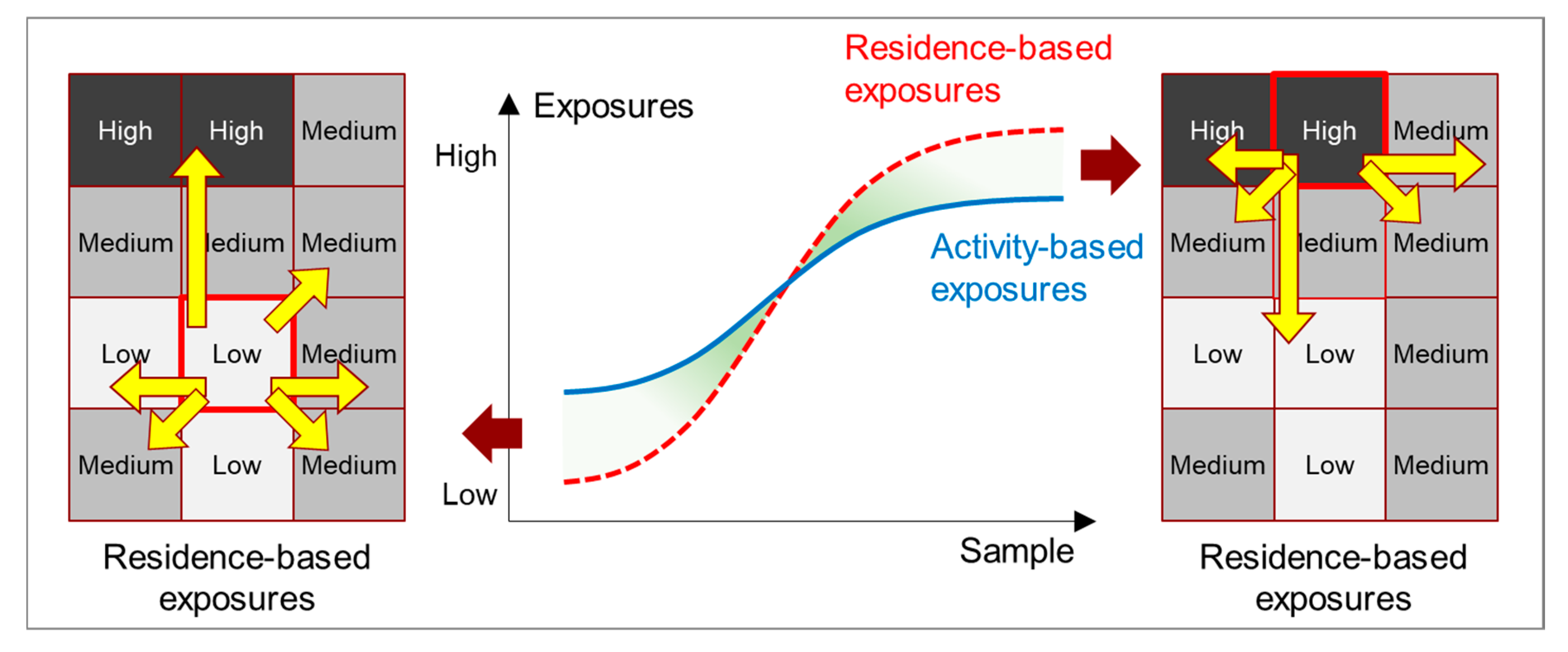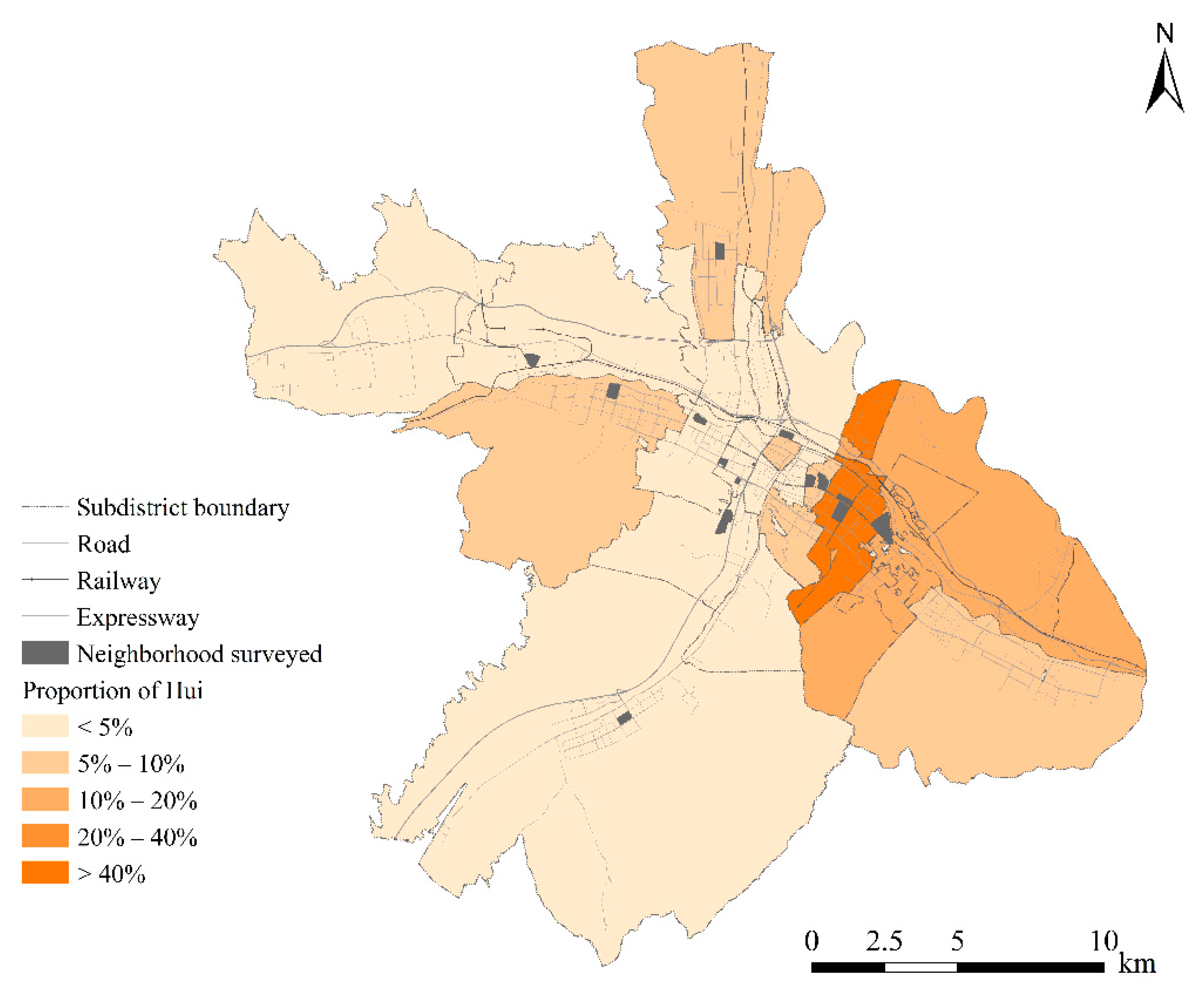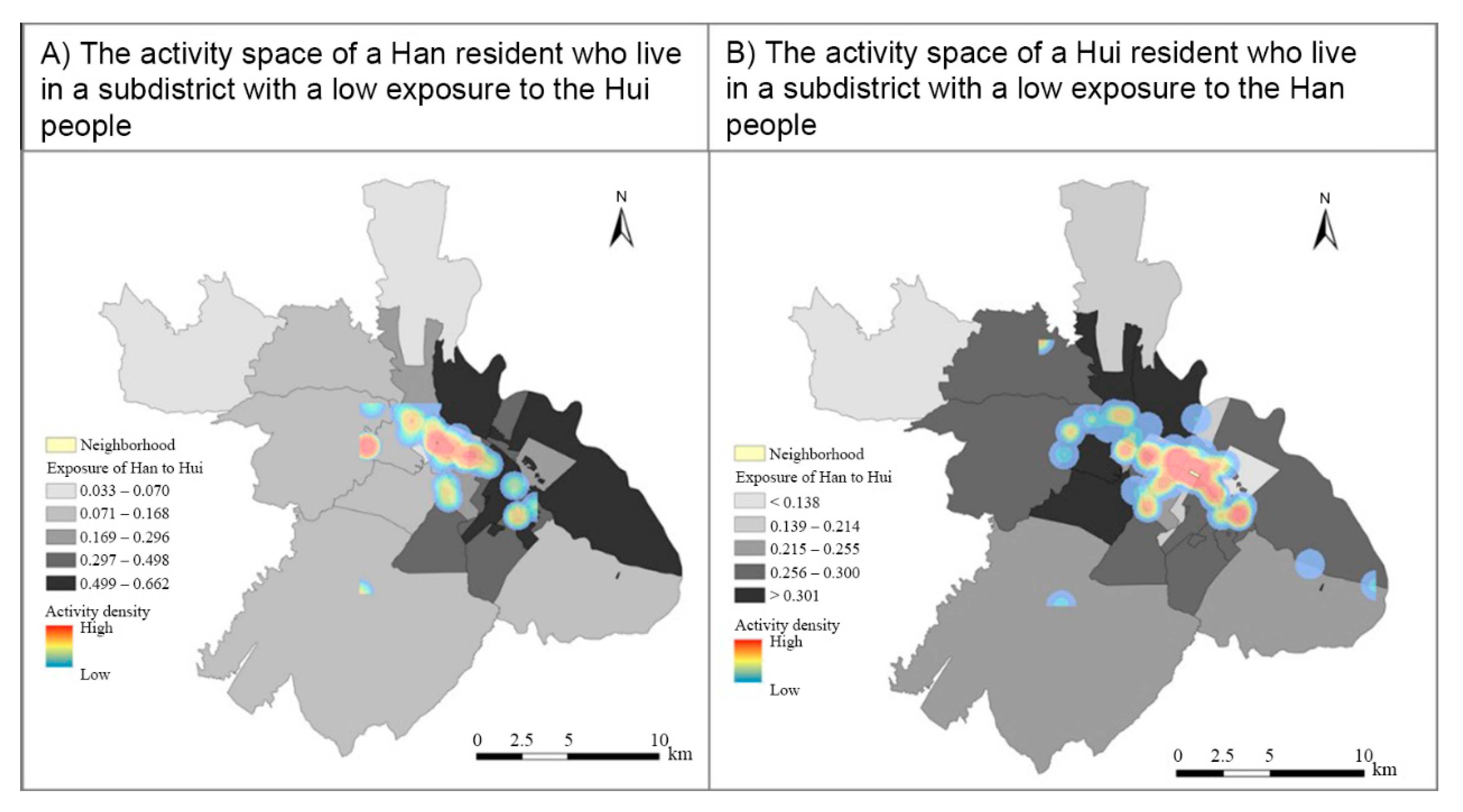Examining Ethnic Exposure through the Perspective of the Neighborhood Effect Averaging Problem: A Case Study of Xining, China
Abstract
1. Introduction
2. Literature Review
2.1. From the Uncertain Geographic Context Problem (UGCoP) to the Neighborhood Effect Averaging Problem (NEAP)
2.2. Activity-Based Segregation and Exposure
3. Study Area, Data, and Methods
3.1. Study Area and Data
3.2. Measuring Residence-Based and Activity-Based Ethnic Exposure
3.3. Measuring the Extent of Neighborhood Effect Averaging
3.4. One-Limit Censored Tobit Model Analysis
4. Results
4.1. Descriptive Analysis
4.2. Modeling Results
5. Conclusions
Author Contributions
Funding
Conflicts of Interest
References
- Kwan, M.-P. The neighborhood effect averaging problem (NEAP): An elusive confounder of the neighborhood effect. Int. J. Environ. Res. Public Health 2018, 15, 1841. [Google Scholar] [CrossRef]
- Kwan, M.-P. The uncertain geographic context problem. Ann. Am. Assoc. Geogr. 2012, 102, 958–968. [Google Scholar] [CrossRef]
- Schwanen, T.; Wang, D. Well-being, context, and everyday activities in space and time. Ann. Am. Assoc. Geogr. 2014, 104, 833–851. [Google Scholar] [CrossRef]
- Chen, X.; Kwan, M.-P. Contextual uncertainties, human mobility, and perceived food environment: The uncertain geographic context problem in food access research. Am. J. Public Health 2015, 105, 1734–1737. [Google Scholar] [CrossRef] [PubMed]
- Park, Y.M.; Kwan, M.-P. Individual exposure estimates may be erroneous when spatiotemporal variability of air pollution and human mobility are ignored. Health Place 2017, 43, 85–94. [Google Scholar] [CrossRef] [PubMed]
- Dewulf, B.; Neutens, T.; Lefebvre, W.; Seynaeve, G.; Vanpoucke, C.; Beckx, C.; Van de Weghe, N. Dynamic assessment of exposure to air pollution using mobile phone data. Int. J. Health Geogr. 2016, 15, 14. [Google Scholar] [CrossRef] [PubMed]
- Shafran-Nathan, R.; Levy, I.; Broday, D.M. Exposure estimation errors to nitrogen oxides on a population scale due to daytime activity away from home. Sci. Total Environ. 2017, 580, 1401–1409. [Google Scholar] [CrossRef]
- Yu, H.; Russell, A.; Mulholland, J.; Huang, Z. Using cell phone location to assess misclassification errors in air pollution exposure estimation. Environ. Pollut. 2018, 233, 261–266. [Google Scholar] [CrossRef]
- Ma, X.; Li, X.; Kwan, M.-P.; Chai, Y. Who Could Not Avoid Exposure to High Levels of Residence-Based Pollution by Daily Mobility? Evidence of Air Pollution Exposure from the Perspective of the Neighborhood Effect Averaging Problem (NEAP). Int. J. Environ. Res. Public Health 2020, 17, 1223. [Google Scholar] [CrossRef]
- Kim, J.; Kwan, M.-P. How neighborhood effect averaging may affect assessment of individual exposures to air pollution: A study of ozone exposures in Los Angeles. Ann. Am. Assoc. Geogr. 2020, accepted. [Google Scholar]
- Kim, J.; Kwan, M.-P. Beyond commuting: Ignoring individuals’ activity-travel patterns may lead to inaccurate assessments of their exposure to traffic congestion. Int. J. Environ. Res. Public Health 2019, 16, 89. [Google Scholar] [CrossRef] [PubMed]
- Wong, D.W.; Shaw, S.L. Measuring segregation: An activity space approach. J. Geogr. Syst. 2011, 13, 127–145. [Google Scholar] [CrossRef] [PubMed]
- Kwan, M.-P. Beyond space (as we knew it): Toward temporally integrated geographies of segregation, health, and accessibility: Space–time integration in geography and GIScience. Ann. Am. Assoc. Geogr. 2013, 103, 1078–1086. [Google Scholar] [CrossRef]
- Wang, D.; Li, F. Daily activity space and exposure: A comparative study of Hong Kong’s public and private housing residents’ segregation in daily life. Cities 2016, 59, 148–155. [Google Scholar] [CrossRef]
- Krivo, L.J.; Washington, H.M.; Peterson, R.D.; Browning, C.R.; Calder, C.A.; Kwan, M.-P. Social isolation of disadvantage and advantage: The reproduction of inequality in urban space. Soc. Forces 2013, 92, 141–164. [Google Scholar] [CrossRef]
- Jones, M.; Pebley, A.R. Redefining neighborhoods using common destinations: Social characteristics of activity spaces and home census tracts compared. Demography 2014, 51, 727–752. [Google Scholar] [CrossRef]
- Park, Y.M.; Kwan, M.-P. Beyond residential segregation: A spatiotemporal approach to examining multi-contextual segregation. Comput. Environ. Urban Syst. 2018, 71, 98–108. [Google Scholar] [CrossRef]
- Shareck, M.; Kestens, Y.; Frohlich, K.L. Moving beyond the residential neighborhood to explore social inequalities in exposure to area-level disadvantage: Results from the Interdisciplinary Study on Inequalities in Smoking. Soc. Sci. Med. 2014, 108, 106–114. [Google Scholar] [CrossRef]
- Kwan, M.-P. The limits of the neighborhood effect: Contextual uncertainties in geographic, environmental health, and social science research. Ann. Am. Assoc. Geogr. 2018, 108, 1482–1490. [Google Scholar] [CrossRef]
- Wei, Q.; She, J.; Zhang, S.; Ma, J. Using individual GPS trajectories to explore foodscape exposure: A case study in Beijing metropolitan area. Int. J. Environ. Res. Public Health 2018, 15, 405. [Google Scholar] [CrossRef]
- Kwan, M.-P.; Wang, J.; Tyburski, M.; Epstein, D.H.; Kowalczyk, W.J.; Preston, K.L. Uncertainties in the geographic context of health behaviors: A study of substance users’ exposure to psychosocial stress using GPS data. Int. J. Geogr. Inf. Sci. 2019, 33, 1176–1195. [Google Scholar] [CrossRef]
- Zhao, P.; Kwan, M.-P.; Zhou, S. The uncertain geographic context problem in the analysis of the relationships between obesity and the built environment in Guangzhou. Int. J. Environ. Res. Public Health 2018, 15, 308. [Google Scholar] [CrossRef] [PubMed]
- Ma, J.; Tao, Y.; Kwan, M.-P.; Chai, Y. Assessing Mobility-Based Real-Time Air Pollution Exposure in Space and Time Using Smart Sensors and GPS Trajectories in Beijing. Ann. Am. Assoc. Geogr. 2020, 110, 1–15. [Google Scholar] [CrossRef]
- Tan, Y.; Chai, Y.; Kwan, M.-P. The impact of the uncertain geographic context on the space-time behavior analysis: A case study of Xining, China. Acta Geogr. Sin. 2017, 72, 657–670. (In Chinese) [Google Scholar] [CrossRef]
- Duncan, O.D.; Duncan, B. A methodological analysis of segregation indexes. Am. Sociol. Rev. 1955, 20, 210–217. [Google Scholar] [CrossRef]
- Massey, D.S.; Denton, N.A. The dimensions of residential segregation. Soc. Forces 1988, 67, 281–315. [Google Scholar] [CrossRef]
- Marcuse, P.; Van Kempen, R. (Eds.) Of States and Cities: The Partitioning of Urban Space; Oxford University Press: Oxford, UK, 2002. [Google Scholar]
- Holloway, S.R.; Ellis, M.; Wright, R.; Hudson, M. Partnering ‘out’and fitting in: Residential segregation and the neighbourhood contexts of mixed-race households. Popul. Space Place 2005, 11, 299–324. [Google Scholar] [CrossRef]
- Wang, D.; Schwanen, T.; Mao, Z. Does exposure to richer and poorer neighborhoods influence wellbeing? Cities 2019, 95, 102408. [Google Scholar] [CrossRef]
- Li, F.; Wang, D. Measuring urban segregation based on individuals’ daily activity patterns: A multidimensional approach. Environ. Plan. A 2017, 49, 467–486. [Google Scholar] [CrossRef]
- Schnell, I.; Yoav, B. The sociospatial isolation of agents in everyday life spaces as an aspect of segregation. Ann. Am. Assoc. Geogr. 2001, 91, 622–636. [Google Scholar] [CrossRef]
- Tan, Y.; Chai, Y.; Chen, Z. Social-contextual exposure of ethnic groups in urban China: From residential place to activity space. Popul. Space Place 2019, 25, e2248. [Google Scholar] [CrossRef]
- Statistical Bulletin on National Economic and Social Development of Xining in 2018. Available online: http://www.tjcn.org/tjgb/29qh/35836_2.html (accessed on 10 January 2019). (In Chinese).
- Morrill, R.L. On the measure of geographic segregation. Geogr. Res. Forum 1991, 11, 25–36. [Google Scholar]
- Zhao, P.; Howden-Chapman, P. Social inequalities in mobility: The impact of the hukou system on migrants’ job accessibility and commuting costs in Beijing. Int. Dev. Plan. Rev. 2010, 32, 363–384. [Google Scholar] [CrossRef]
- Zhou, X.; Chen, Z.; Yeh, A.G.O. Workplace segregation of rural migrants in urban China: A case study of Shenzhen using cellphone big data. Environ. Plan. B 2020, in press. [Google Scholar] [CrossRef]
- Qian, J. Geographies of public space: Variegated publicness, variegated epistemologies. Prog. Hum. Geog. 2020, 44, 77–98. [Google Scholar] [CrossRef]
- Wang, Q.; Phillips, N.E.; Small, M.L.; Sampson, R.J. Urban mobility and neighborhood isolation in America’s 50 largest cities. Proc. Natl. Acad. Sci. USA 2018, 115, 7735–7740. [Google Scholar] [CrossRef]
- Fincher, R.; Iveson, K.; Leitner, H.; Preston, V. Planning in the multicultural city: Celebrating diversity or reinforcing difference? Prog. Plan. 2014, 92, 1–55. [Google Scholar] [CrossRef]
- Matejskova, T.; Leitner, H. Urban encounters with difference: The contact hypothesis and immigrant integration projects in eastern Berlin. Soc. Cult. Geog. 2011, 12, 717–741. [Google Scholar] [CrossRef]



| Variables | Final Sample | Han Ethnic Group | Hui Ethnic Group | Sig. 1 | ||||
|---|---|---|---|---|---|---|---|---|
| Number | % | Number | % | Number | % | |||
| Total | 1065 | - | 850 | - | 215 | - | - | |
| Gender | Female | 511 | 48.0% (49.4%) 2 | 415 | 48.8% | 96 | 44.7% | 0.27 |
| Male | 554 | 52.0% (50.6%) | 435 | 51.2% | 119 | 55.3% | ||
| Age 3 | <30 | 100 | 9.4% (9.9%) | 69 | 8.1% | 31 | 14.4% | 0.01 |
| 30–50 | 647 | 60.8% (64.2%) | 515 | 60.6% | 132 | 61.4% | ||
| >50 | 318 | 29.9% (25.9%) | 266 | 31.3% | 52 | 24.2% | ||
| Monthly Income 4 (CNY) | <2000 | 388 | 36.4% (40.6%) | 254 | 29.9% | 134 | 62.3% | 0.00 |
| 2000–5000 | 580 | 54.5% (50.3%) | 509 | 59.9% | 71 | 33.0% | ||
| >5000 | 97 | 9.1% (9.1%) | 87 | 10.2% | 10 | 4.7% | ||
| Hukou Status | Temporary migrants | 227 | 21.3% (26.5%) | 160 | 18.8% | 67 | 31.2% | 0.00 |
| Local | 838 | 78.7% (73.6%) | 690 | 81.2% | 148 | 68.8% | ||
| Education Attainment | Middle school or below | 391 | 36.7% (35.0%) | 237 | 27.9% | 154 | 71.6% | 0.00 |
| High school | 407 | 38.2% (42.4%) | 360 | 42.4% | 47 | 21.9% | ||
| College or above | 267 | 25.1% (22.7%) | 253 | 29.8% | 14 | 6.5% | ||
| Employment Status | Full-time job | 490 | 46.0% (43.4%) | 438 | 51.5% | 52 | 24.2% | 0.00 |
| Part-time job or other | 212 | 19.9% (21.0%) | 131 | 15.4% | 81 | 37.7% | ||
| Unemployed | 210 | 19.7% (17.2%) | 187 | 22.0% | 23 | 10.7% | ||
| Retired | 153 | 14.4% (18.5%) | 94 | 11.1% | 59 | 27.4% | ||
| Quintile of Residence-Based Exposure | Residence-Based Exposures (Mean) | Activity-Based Exposures (Mean) | Differences between Average Activity-Based and Residence-Based Exposures | Sig. 1 (Paired t-Test) | Number of Respondents |
|---|---|---|---|---|---|
| 1st | 0.182 | 0.229 | 0.047 2 | 0.000 | 246 |
| 2nd | 0.236 | 0.269 | 0.033 | 0.000 | 232 |
| 3rd | 0.297 | 0.292 | −0.005 | 0.108 | 229 |
| 4th | 0.417 | 0.350 | −0.067 | 0.000 | 188 |
| 5th | 0.561 | 0.459 | −0.102 | 0.000 | 193 |
| Quintile of Residence-based Exposure | Mean | Standard Deviation | Number of Respondents |
|---|---|---|---|
| 1st | 0.053 | 0.073 | 246 |
| 2nd | 0.045 | 0.057 | 232 |
| 3rd | 0.040 | 0.052 | 229 |
| 4th | 0.068 | 0.077 | 188 |
| 5th | 0.116 | 0.149 | 193 |
| Sig. 1 | 0.000 |
| Variables | Model 1 (Han Sample) | Model 2 (Hui Sample) | ||||
|---|---|---|---|---|---|---|
| Coefficient | t | P > |t| | Coefficient | t | P > |t| | |
| Gender (Ref: Male) | ||||||
| Female | −0.01 | −0.73 | 0.47 | −0.01 | −1.00 | 0.32 |
| Age (Ref: >50) | ||||||
| <30 | 0.00 | 0.17 | 0.87 | 0.00 | 0.28 | 0.78 |
| 30–50 | −0.01 | −0.45 | 0.66 | 0.01 | 1.52 | 0.13 |
| Education (Ref: College or above) | ||||||
| Middle school or below | −0.03 | −1.72 | 0.09 | 0.00 | −0.25 | 0.80 |
| High school | −0.02 | −1.46 | 0.15 | 0.00 | −0.11 | 0.92 |
| Hukou (Ref: Temporary migrants) | ||||||
| Local | 0.02 1 | 2.10 | 0.04 | 0.00 | −0.69 | 0.49 |
| Employment (Ref: Unemployed) | ||||||
| Full-time job | −0.02 | −1.35 | 0.18 | −0.03 | −2.83 | 0.01 |
| Part-time job or other | 0.02 | 1.02 | 0.31 | 0.00 | −0.22 | 0.83 |
| Retired | −0.02 | −0.96 | 0.34 | −0.02 | −1.75 | 0.08 |
| Income (Ref: >5000) | ||||||
| <2000 | −0.01 | −0.42 | 0.68 | 0.01 | 0.33 | 0.74 |
| 2000–5000 | 0.00 | 0.17 | 0.87 | 0.01 | 0.92 | 0.36 |
| Deviation index in each type of activity places | ||||||
| Workplaces | 0.15 | 15.23 | 0.00 | 0.27 | 14.26 | 0.00 |
| Relatives’ home | 0.19 | 6.58 | 0.00 | 0.24 | 3.28 | 0.00 |
| Shops | 0.38 | 11.01 | 0.00 | 0.17 | 2.61 | 0.01 |
| Restaurants | 0.07 | 2.09 | 0.04 | 0.05 | 0.36 | 0.72 |
| Parks and green spaces | 0.22 | 8.05 | 0.00 | 0.35 | 4.10 | 0.00 |
| Hospitals | 0.15 | 5.15 | 0.00 | 0.30 | 3.69 | 0.00 |
| Religious sites | −0.19 | −0.50 | 0.61 | 0.38 | 3.89 | 0.00 |
| (Constant) | 0.01 | 0.31 | 0.76 | 0.00 | −0.14 | 0.89 |
| Activity Places | Average Activity Duration | Percentage of Participants | ||
|---|---|---|---|---|
| Hui Residents | Han Residents | Hui Residents | Han Residents | |
| min | min | % | % | |
| Workplaces | 471 | 423 | 53.5 | 63.6 |
| Relatives’ home | 62 | 46 | 16.7 | 16.2 |
| Shops | 62 | 46 | 23.7 | 39.4 |
| Restaurants | 12 | 36 | 7.9 | 21.5 |
| Parks and green spaces | 26 | 50 | 11.2 | 26.4 |
| Hospitals | 18 | 16 | 13.7 | 5.2 |
| Religious sites | 52 | 1 | 16.7 | 1.3 |
© 2020 by the authors. Licensee MDPI, Basel, Switzerland. This article is an open access article distributed under the terms and conditions of the Creative Commons Attribution (CC BY) license (http://creativecommons.org/licenses/by/4.0/).
Share and Cite
Tan, Y.; Kwan, M.-P.; Chen, Z. Examining Ethnic Exposure through the Perspective of the Neighborhood Effect Averaging Problem: A Case Study of Xining, China. Int. J. Environ. Res. Public Health 2020, 17, 2872. https://doi.org/10.3390/ijerph17082872
Tan Y, Kwan M-P, Chen Z. Examining Ethnic Exposure through the Perspective of the Neighborhood Effect Averaging Problem: A Case Study of Xining, China. International Journal of Environmental Research and Public Health. 2020; 17(8):2872. https://doi.org/10.3390/ijerph17082872
Chicago/Turabian StyleTan, Yiming, Mei-Po Kwan, and Zifeng Chen. 2020. "Examining Ethnic Exposure through the Perspective of the Neighborhood Effect Averaging Problem: A Case Study of Xining, China" International Journal of Environmental Research and Public Health 17, no. 8: 2872. https://doi.org/10.3390/ijerph17082872
APA StyleTan, Y., Kwan, M.-P., & Chen, Z. (2020). Examining Ethnic Exposure through the Perspective of the Neighborhood Effect Averaging Problem: A Case Study of Xining, China. International Journal of Environmental Research and Public Health, 17(8), 2872. https://doi.org/10.3390/ijerph17082872






